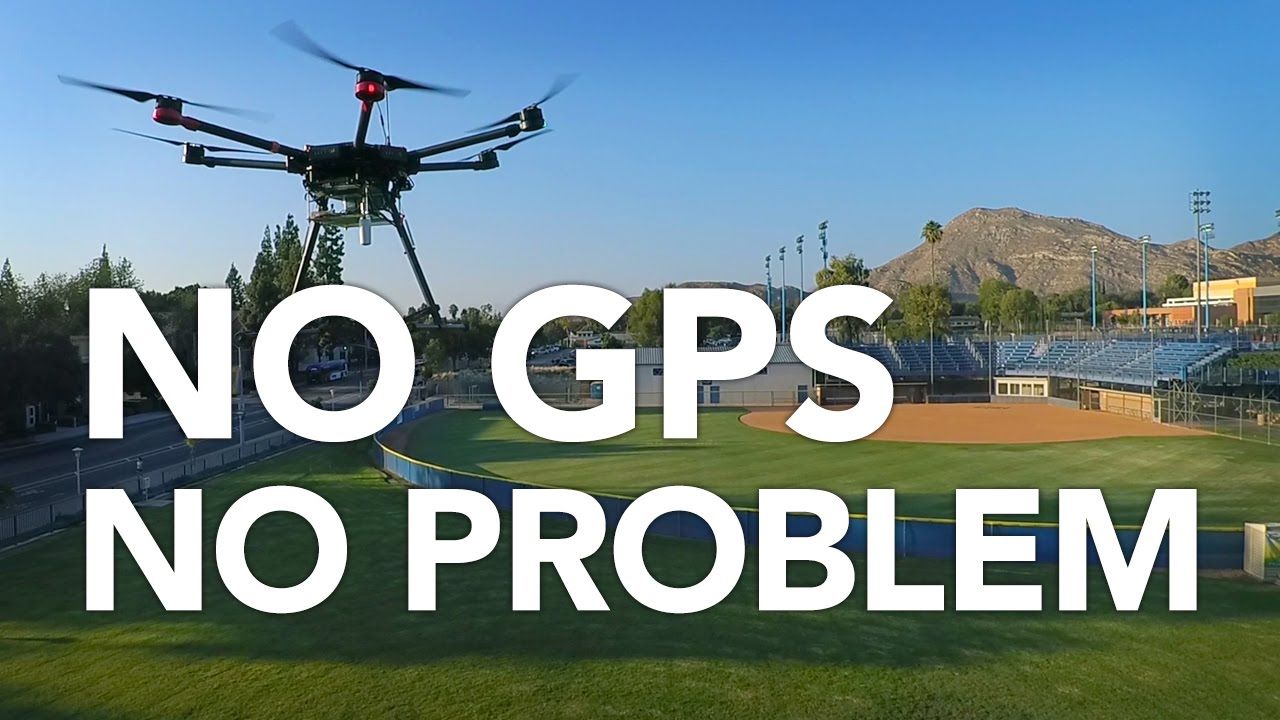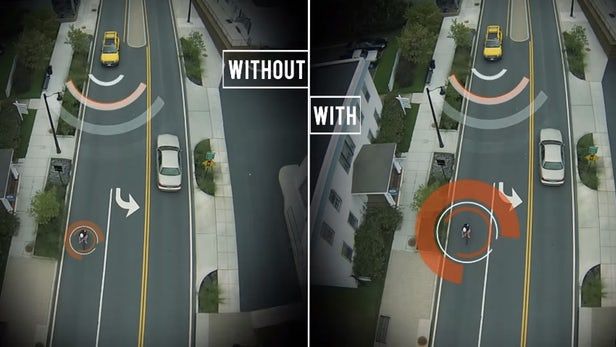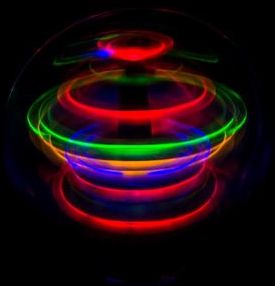Page 10786
Oct 16, 2016
Simple gadget puts bikes on cars’ radar
Posted by Shane Hinshaw in categories: futurism, transportation
In the near future, we’re going to see an increasing number of Collision Avoidance System-equipped cars on the roads. Stated simply, the technology uses an integrated forward-looking radar system to alert drivers when they’re rapidly approaching obstacles such as other vehicles. If those other vehicles are bicycles, however, their rear profile can make them difficult for the radar to detect. That’s where iLumaware’s Shield TL comes in.
Inventors Chris Mogridge and Alexis Stobbe created the device by analyzing how stealth technology works, then essentially going in the opposite direction – whereas stealth vehicles are designed to evade radar signals, the Shield is made to catch those signals and reflect them back to the cars. It does this purely via its unique shape, not emitting any actual signal itself.
In field tests, it boosted bicycles’ radar signature by up to 100 percent, and thus increased the distance at which they could be detected by Collision Avoidance Systems.
Oct 16, 2016
For the first time, scientists have measured sun’s real-time energy
Posted by Shane Hinshaw in categories: nuclear energy, physics
Physicists on the Borexino neutrino experiment at Italian physics laboratory INFN in Gran Sasso announced in Nature that they have detected neutrinos produced deep inside the sun.
Neutrinos, which constantly stream through us, interact very rarely with other matter. When created in nuclear reactions inside the sun, they fly through dense solar matter in seconds and can reach the Earth in eight minutes.
Oct 16, 2016
No satellites needed for next-gen navigation system that uses “signals of opportunity”
Posted by Shane Hinshaw in categories: encryption, internet, military, mobile phones, robotics/AI, satellites

The Global Positioning System (GPS) is a great navigation aid – unless you lose the signal while negotiating a complicated spaghetti junction. That’s bad enough for conventional cars, but for autonomous vehicles it could be catastrophic, so the University of California, Riverside’s Autonomous Systems Perception, Intelligence, and Navigation (ASPIN) Laboratory under Zak Kassas is developing an alternative navigation system that uses secondary radio signals, such as from cell phone systems and Wi-Fi to either complement existing GPS-based systems or as a standalone alternative that is claimed to be highly reliable, consistent, and tamper-proof.
Today, there are two global satellite navigation systems in operation, the US GPS and the Russian GLONASS, with the European Galileo system set to become fully operational in the next few years, and plans for the Chinese Beidou system to extend globally by 2020. These have revolutionized navigation, surveying, and a dozen other fields, but GPS and related systems still leave much to be desired. By their nature, GPS signals are weak and positions need to be confirmed by several satellites, so built up areas or mountainous areas can make the system useless. In addition, GPS signals can be deliberately or accidentally jammed or spoofed due to insufficient encryption and other protections.
Oct 16, 2016
Antimatter Probe May Do Proxima b Interstellar Flyby
Posted by Klaus Baldauf in category: space travel
An antimatter propulsion drive probe could be the first human-made spacecraft to orbit the newly-discovered extrasolar earthlike planet Proxima b. Or so says Gerald Jackson, the president of the Chicago-based Hbar technologies, whose antimatterdrive.org began a $200,000 Kickstarter campaign this weekend.
The idea is to use the fledgling antimatter propulsion technology to travel 4.2 light years to the newfound exo-earth circling Proxima Centauri, the Sun’s nearest stellar neighbor.
“Our antimatter drive project proposes an initial mission taking as long as 90 years, traveling at 5% of the speed of light for the majority of that duration,” Jackson, a former Fermilab physicist, told me. The hope is that the craft could eventually go into orbit around a nearby earthlike planet such as Proxima b.
Continue reading “Antimatter Probe May Do Proxima b Interstellar Flyby” »
Oct 16, 2016
US Air Force’s X-37B space plane has been in orbit for 500 days, but why?
Posted by Karen Hurst in categories: military, robotics/AI, space travel
Fuel/ energy efficient method for travel is my guess.
The US Air Force’s unmanned X-37B space plane has now spent more than 500 days orbiting the Earth, without statement or explanation. The 29-foot unmanned plane is part of the Air Force’s orbital program.
Launched May 20, 2015, it is the program’s fourth flight (hence its other name, OTV-4 for Orbital Test Vehicle-4). The first OTV took flight in 2010 and spent 224 days in orbit; two others brought the total number of OTV days in orbit before 2015 to 1,367, according to the Air Force.
Continue reading “US Air Force’s X-37B space plane has been in orbit for 500 days, but why?” »
Oct 16, 2016
Saudi Commentator Praises Israel; Latest Sign of Warming Ties Between Jewish and Arab States
Posted by Karen Hurst in categories: economics, security, sustainability
Could technology build friendships for Israel across the Middle East?
Israel and Saudi Arabia should form a “collaborative alliance” to become the “twin pillars of regional stability” in the Middle East, a top Saudi lobbyist wrote in The Hill on Tuesday, in what is the latest sign of warming and increasingly-public ties between Arab countries and the Jewish state.
Salman al-Ansari, the founder and president of the Saudi American Public Relations Affairs Committee, asserted that Israel can assist Saudi Arabia in implementing its Vision 2030, the Kingdom’s blueprint to diversify its economy. Al-Ansari specifically mentioned Israel’s expertise in mining and water technology, which makes Israel “extraordinarily qualified to help Saudi Arabia with its ambitious desalination plans.”
Oct 16, 2016
Russia WW3 Weapon: Nikola Tesla’s Death Ray In Vladimir Putin’s Possession?
Posted by Karen Hurst in category: futurism
New details are emerging about Nikola Tesla’s rumored “Death Ray” technology being in the possession of Russia. Declassified FBI documents reveal that the technology actually exists and was hidden from the public after his death.
Oct 16, 2016
A new spin on superconductivity: Harvard physicists pass spin information through a superconductor
Posted by Karen Hurst in categories: nanotechnology, quantum physics, supercomputing
New method for information storage via QC uncovered.
Abstract: Researchers from the Harvard John A. Paulson School of Engineering and Applied Sciences (SEAS) have made a discovery that could lay the foundation for quantum superconducting devices. Their breakthrough solves one the main challenges to quantum computing: how to transmit spin information through superconducting materials.
Every electronic device — from a supercomputer to a dishwasher — works by controlling the flow of charged electrons. But electrons can carry so much more information than just charge; electrons also spin, like a gyroscope on axis.
















